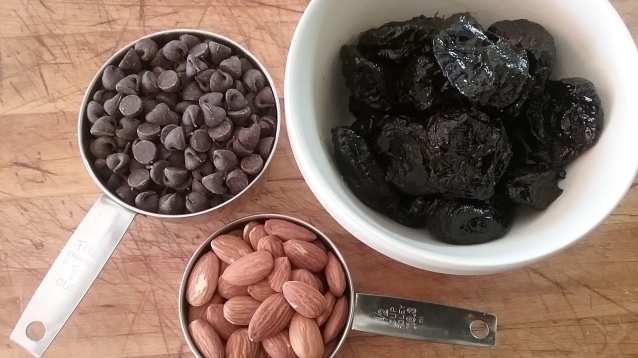Childhood memories of Cadbury Fruit and Nut chocolate bars from the years we lived in England come to mind now and then. Pastelerias (cake shops) in Mexico make very tempting, creative cakes, evidence of European immigrant and foreign government influence. What about a chocolate cake that takes its inspiration from Cadbury’s raisins and almonds? Am I starting a new thing? No. Recipes for Cadbury cakes are all over the internet, mostly from the U.K. Every time I think I might have come up with a new recipe, I find it’s been on the internet for years. Oh well, here’s a very different chocolate cake from this immigrant, me. It’s made moist with prune puree, filled with almonds and raisins, and special enough that it will be our New Year’s Eve dessert and see us into 2021.
Prune puree works some kind of culinary magic, so that less fat and sugar still produce plenty of sweetness and tenderness. Only 1/4 cup of sugar is used, and 1/4 cup coconut oil or butter. Coconut oil seems to work its own chemistry, making for more tender cakes.
At the risk of sounding like a commercial for Costco, bakers south of the border can get very good Kirkland brand almendras (almonds), ciruelas secas (prunes), and chispas de chocolate (chocolate chips). But don’t go to Costco for pasas (raisins). Mexico’s markets and little stores have the best, tinted with reds and purples, and two to three times larger than raisins north of the border. They taste sweeter, too, but maybe that’s due to my own enthusiasm for these colorful morsels. In Mexico, you can find them in generically labeled bags or in bulk.
Our New Year’s Eve menu is yet to be planned. Maybe French onion soup with a cheese souffle. No tamales or atole tomorrow night, you ask? Well, when Emperor Maximilian thought he could rule Mexico, his plans failed, but the wonderful cuisine of France stayed. I don’t think we’ll be the only ones in Mexico enjoying French dishes tomorrow night. Bon appetit! I mean, Buen provecho!
The Chocolate Prune Cake is already baked, and because it’s extra moist, it will still be fresh and tender tomorrow evening. That is, if we don’t eat it all by then. You may notice there remained five pieces for the photo above. Will I ever learn to take photos, then eat?
For New Year’s Eve, Russ and I will be staying home with our pup, Yolo, enjoying each other’s company, maybe a movie, and definitely good food. May you enjoy the same. Feliz Año Nuevo!
Chocolate Prune Cake ~ 9 – 12 servings
- 1.5 cups (10.6 oz/300 g) pitted prunes
- 1 cup (6.7 oz/190 g) chocolate chips or chopped dark chocolate, divided
- 2 large eggs
- 1/4 cup (60 ml) melted coconut oil or butter
- 1 teaspoon vanilla
- 1 cup (4.5 oz/125 g) whole wheat pastry flour or regular whole wheat flour (for gluten free, see notes below)
- 1/2 cup (1.65 oz/48 g) unsweetened cocoa powder
- 1/4 cup (1.75 oz/50 g) sugar
- 2 teaspoons baking powder
- 1/2 teaspoon baking soda
- 1/2 teaspoon salt
- 1/2 cup (3 oz/85 g) almonds, coarsely chopped
- 1/2 cup (2.25 oz/63 g) raisins
- Confectioner’s sugar to dust on cake (optional)
- Cut parchment paper to fit bottom of 8″ or 9″ baking pan. Grease and flour sides of pan.
- Simmer prunes in 1.5 cups (355 ml) water for 10 minutes, or until prunes are very tender. (See note below.)
- Puree undrained prunes, while still very warm, in food processor with 1/2 cup chocolate chips, eggs, oil and vanilla.
- Preheat oven to 350° F (180° C).
- Sift dry ingredients into large bowl.
- Stir prune mixture into dry ingredients with remaining 1/2 cup chocolate chips, almonds and raisins.
- Pour into prepared baking pan and bake for 35-45 minutes, or until toothpick tests mostly dry. This is a very moist cake, so some crumbs will stick to toothpick when cake is done.
- Cook in pan for 5 minues.
- Run a thin knife around inside edges and invert onto cake rack to cool.
~ Notes
~ Prunes from Costco are very moist, almost wet. But if your prunes are the drier variety, use 1 3/4 cups of water to simmer prunes.
~ Pastry flour, with its lower gluten content, is preferred for tender cakes, but not available in Mexico unless you have a large supermarket that carries Bob’s Red Mill products. Most of us in Mexico will have to make do with regular flour, whole wheat or white.
~ For a gluten free cake, replace the wheat flour with Bob’s Red Mill 1 – 1 Baking Flour. According to Bob’s website, this flour can replace regular flour with an equal amount of Bob’s Red Mill 1 – 1 flour, cup per cup. I have not tried this, but it has very good reviews on Amazon.
© 2009-2020 COOKING IN MEXICO ALL RIGHTS RESERVED
All photos and text are copyright protected. Do not copy or reproduce without permission.




















